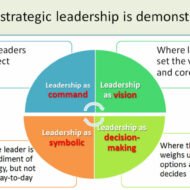Currently Browsing: Leadership
Posted by Managementguru in Human Resource, Leadership, Motivation
on Mar 17th, 2015 | 0 comments

6 Things a Manager Can Learn From MS Dhoni Leading from the front Staying cool Sharing the due credit with fellow-men Encouraging team members to make them better performers Staying Grounded Resource Utilization No, this article is certainly not about our Indian Cricket team’s captain; but he has a lot to offer to prove my point. Yes, I was contemplating about the various leaders- both in the political and economic sectors and how their attitude and perspective has a direct effect on the followers or sub-ordinates. I thought it would be good to start from M.S.Dhoni, the all powerful leader in his own way standing tall and cool. Don’t miss this powerpoint: The powerpoint given here depicts the different leadership styles pertaining to an organization – be it business, service, non-profit or educational. The motive may differ for each of the listed organizations above but all have to function effectively to reach that ulterior motive. There can’t be a second thought or opinion on this and how the emotional quotient of a leader impacts employee motivation and engagement is something phenomenal. It is directly evident from the functioning style of the employees and their attitude even when you just enter an organization. The impact of leadership styles on employee motivation and performance from Shyama Shankar My Bad Encounter: Recently I had been to a dermatologist for a consultation and even before I could inquire about the doctor’s availability, the girl at the front desk was very particular to know if I would be willing to pay three hundred bucks. I was taken aback to know that the fee was two hundred bucks for visiting during regular hours and three hundred for late hours (It was a sunday and late hours meant visiting the doctor after 12 noon). The hundred rupees did not matter to me at all but the way in which the man has trained his staff to put the patients into an uneasy position made me think – “Where service has to be the motto of his profession, money has REWRITTEN the ETIQUETTES in it own cruel way.” Matched Leadership: How to Use Leadership Styles Effectively Leadership style is one of the most debated topics in management which has influenced a great number of managers and employees. Leadership style extensively influences employee’s commitment and dedication. A participative and democratic kind of leader creates a positive work atmosphere, a coercive leader creates an unbalanced and negative atmosphere; nevertheless all kinds of leaders create a serious impact whether negative or positive. Transformational leaders provide a vision and a sense of mission, inspire pride, and gain respect and trust through charisma, as opposed to a simple exchange and agreement,(Bass et al.1990) whereas Transactional leaders communicate with their subordinates to explain how a task must be done and let them know that there will be rewards for a job done well (Avolio et al.1991). Laissez-faire leadership is a passive kind of leadership style, seen as not caring about other’s issues. There is no relationship exchange between the leader and the followers. It represents a non-transactional kind of leadership style in which necessary decisions are not made, actions are delayed, leadership responsibilities ignored, and authority unused. Now it is time to enjoy some funny quotes on Leadership: Only one man in a thousand is a leader of men — the other 999 follow women. Groucho Marx First rule of leadership: everything is your fault. A Bug’s Life The problem with being a leader is that you’re never sure if you’re being followed or chased. Claire A. Murray The key to being a good manager is keeping the people who hate me away from those who are still...

Posted by Managementguru in Business Management, CSR, Entrepreneurship, Human Resource, Leadership, Strategy
on Dec 4th, 2014 | 0 comments

Does Your Company Have What It Takes to be A Leader? Corporations that are considered leaders in terms of business performance take a common approach to CSR. The blueprint for how corporations can maximize their investments in CSR contain five essential ingredients- Business-based social purposeClear theory of changeQuality and depth of informationConcentrated effort, andPartnering with experts. 1. Business-based social purpose: There have been too many examples of CSR programs that ignore business fundamentals. Leadership-level CSR programs always directly reflect what the business is and what it does. An “innovative CSR initiative” can emphasize the company’s business purpose and flawlessly leverage its operational competencies. The social purpose of a business is aligned with and supports social issues in a way that is consistent with the unique culture and character of the business. Srinivasan Services Trust is a social arm of Sundaram Clayton Limited and TVS Motor company established in 1996 for charitable purposes. The company focuses on improving health, education, women’s empowerment, infrastructure and environment that would bring about changes in the lives of people in a community. 2. Clear theory of change: CSR is becoming indispensable. On the one hand, that’s good news because it proves its business value. On the other hand, it’s getting harder to discriminate one company’s efforts from another’s. CSR leaders develop branded approaches to drive measurable social change. Starbucks Coffee has 8,000 stores, in 34 countries that sell to 30 million customers each week has adopted an unique CSR approach. Their mission is to provide the highest quality coffee in an environment that is consistent worldwide and support the sustainability of their farmers. Starbucks could be considered compliant and even proactive in their responsibilities to stakeholders. They purchase coffee in 20-30 countries per year, as their buying agents spend 240/365 days per year on the road searching for the best coffee farms and developing relationships with customers. It involves mutually agreed upon fair pricing, economic transparency, socially responsible buying, and environmentally friendly expectations. These standards protect the farmer’s business and ensure that Starbucks can support their ethical branding with practices that respect the environment. 3. Quality and Depth of Information: Merely pin-pointing social priorities for community investment is not adequate. Leadership comes from providing employees, customers and external stakeholders with a significant depth of information about the social issue through authentic research, white papers, videos, stories, social media, and so on. Bill & Melinda Gates Foundation or the Gates Foundation is one of the largest private foundations in the world, founded by Bill and Melinda Gates. It was launched in 2000 and is said to be the largest transparently operated private foundation in the world. Guided by the belief that ‘all lives have equal value’, Bill Gates and his wife Melinda Gates the co-chairs explain about their work and their commitment in supporting the government in reaching India’s most vulnerable communities with the services they need to live healthy and productive lives. The Department of Biotechnology (DBT) under the Ministry of Science and Technology of the Government of India and the Bill & Melinda Gates Foundation in collaboration with India’s Biotechnology Industry Research Assistance Council (BIRAC) launched a call for proposals as part of Grand Challenges India to reinvent the toilet. The Department of Biotechnology and the Gates Foundation will each invest US$1 million to support Indian investigators to drive research, development, and production of the “next generation toilet.” 4. Concentrated effort: Leadership is shown by corporations that direct their efforts on one social issue and align all their internal and external resources with this issue. 5. Partnering With Experts: Leadership entails showing a high degree of credibility. This is best done through relationships with social issue experts and not-for-profit organizations. Starbucks hosted...

Posted by Managementguru in Business Management, CSR, Entrepreneurship, Human Resource, Leadership, Strategy
on Dec 4th, 2014 | 0 comments

What it takes to be a Leader What is #Corporate Social Responsibility? High performance is generally measured against key business imperatives including #competitive advantage, #sales, #talent management, #operational efficiency, #return on investment and profitability. It is no longer adequate for a corporation to revel in economic prosperity in isolation from those agents impacted by its actions. Today, a new element of leadership is making an intense difference in weighing business performance: Corporate Social Responsibility. The late 1990s and the early 2000s saw an uptake in businesses giving proceeds or providing volunteers to causes related to their brands. Some called it “corporate social responsibility”; others called it “corporate #philanthropy” or “#corporate citizenship.” Regardless of its title, it was a way for business to increase visibility while raising funds for good. The spotlight is on both increasing the firm’s bottom line and being a good corporate citizen. Keeping abreast of global trends and remaining committed to financial obligations to deliver both private and public benefits have compelled organizations to restructure their frameworks, rules, and business models. Where does the roots of CSR lie? Although the #roots of CSR lie in altruistic activities (such as donations, charity, relief work, etc.) of corporations, globally, the concept of CSR has evolved and now embraces all allied concepts such as triple bottom line, corporate citizenship, philanthropy, #strategic philanthropy, #shared value, #corporate sustainability and business responsibility. You might be wondering what is “Triple bottom line?” (abbreviated as TBL or 3BL) – The term coined by John Elkington in 1994, incorporates the notion of sustainability into business decisions. The TBL is an #accounting framework with three dimensions: social, environmental (or ecological) and financial. “A plethora of research points to a majority of stakeholders agreeing that CSR is a ‘must do’,” and 67% of consumers say they are more likely to buy products and services from a company if they know it supported good causes. Smart Corporations: As a key component in business #strategy and execution, CSR is playing a crucial role in helping organizations to be seen as leaders. Smart corporations are allocating increasing internal resources to CSR investments that include clear objectives and furnish measurable social outcomes. India is a country of multitude contradictions. On the one hand, it has grown to be one of the major economies in the world, and an increasingly important player in the emerging global order, on the other hand, it is still home to the largest number of people living in absolute poverty (even if the proportion of poor people has decreased) and the largest number of malnourished children. This is the sad state of uneven distribution of the benefits of growth which many believe, is the root cause of social unrest. Companies too have been the target of those disconcerted by this lop-sided development and as a result, their contributions to society are under severe scrutiny. Many companies have been astute to sense this development, and have responded proactively while others have done so only when advocated. What it takes to be a Leader-2...

Posted by Managementguru in Business Management, Change management, Decision Making, Entrepreneurship, Human Resource, Leadership, Motivation
on Oct 1st, 2014 | 0 comments

Helpful Tips for Young leaders Here’s a random list of practical advice for young leaders. If you can learn and practice these early in your career, it will help you avoid having to learn them by experience. Delegate, Trust People down the line and Take Advice: While a young business leader may have a flair for leading from the front, one should realize that limited experience is a limiting factor. People are far more likely to take a manager seriously only if he or she listens to and heeds advice. When you act as the sole proprietor of making decisions in your company, people working for you start losing faith in you. It creates what is called “NEGATIVE VIBES” which is not at all good for the overall development of an organization. It is a good practice to communicate and consult with your immediate sub-ordinates before going for big decisions. Learn to let go of control. It is but appropriate to include employees in decision making and you shall be definitely rewarded with more workable strategies. Set an Example: At the same time, one of the most effectual ways to display ability is to lead by example and work hard. A leader must be prepared to shoulder a fair share of the work-load and the #involvement and #commitment he exhibits is undoubtedly infectious and projects him a great team player. The most effective way to earn respect is to lead from the front and help others succeed. Be wary about your conduct, behavior and actions and deeply aware of how it may influence others. Show #conviction: A leader has to have conviction in his/her decisions. If the young manager has done proper ground work and research, then the decision may well be the right one and he/she might be able to stand by and justify the decisions made even when challenged by experienced people. I thoroughly go with this viewpoint “A ‘No‘ uttered from the deepest conviction is better than a ‘Yes‘ merely uttered to please, or worse, to avoid trouble.” Mahatma Gandhi A leader should learn to say ‘NO’ at the right time as indecisiveness is one of history’s greatest leadership killers. Top 25 Leadership Quotes Keep Your Cool in Crisis: Part of being a successful leader is how you handle pressure. In the dynamic business environment you may have to face more challenging and stressful situations and your employees’ judge you based on how you treat such pressure. If you are a man who can see things from the right perspective embracing rationale, your team members will feel reassured by your cool composure, which will in turn develop their trust and confidence in the leader. Manage expectations: Have you ever given a thought about what employees’ expect in you? Communication is a natural gift for leaders and you may very well notice that great leaders are excellent communicators. Here, communication isn’t just talking but a one-on-one, heart-to-heart talk as you would with your close family members. By opening the lines of communication and being accessible, a leader can build a team with people who understand the ##goals and #objectives with ultimate clarity. Present Yourself with Dignity: In Tamil language, there is an age old proverb, “Aal Paadhi Aadai Paadhi”, meaning “#Good Looks Make the Work Easy”. In this modern world, a professional look is mandatory to signify your culture and #personality. A professional, well-dressed businessperson, gives the impression that he thinks that the workplace and the people there are important.” Marilyn Monroe once rightly said “I don’t mind making jokes, but I don’t want to look like...

Posted by Managementguru in Business Management, Human Resource, Leadership, Strategy
on Sep 8th, 2014 | 0 comments

Strategic Leadership in Organizations Every person is bestowed with innumerable opportunities through-out his/her life time. Very few are able to identify those angelistic gateways to success; I don’t agree with the age-old saying “Opportunity knocks the door only once.” In this dynamic world we are in a position to create opportunities and build our businesses around to witness our dreams turning into reality. What is strategic leadership? Have you got the spark in you? What started as a small spark of starting an online book store has instigated Sachin and Binny Bansal to build the top most online retail selling platform Flipkart. Bharat Matrimony founder Murugavel Janakiraman identified the unexplored niche of prospective marriage alliances over the internet by creating an online portal which facilitated girls and boys to project their profiles suitably and search for the man or woman of their dreams with ease minus embarrassment. A spark or an idea is what is needed to get into the groove to achieve something that delivers value not only to the creator but to the public over a period of time. Strategic leaders are not born, they are definitely made; they learn from their mistakes, have an eye for chances, molded by the environment they are exposed to and groom themselves to adapt to the setting. What is Strategic Leadership? Strategic leadership provides the vision and direction for the growth and success of an organization. A strategic leader institutionalizes a vision and helps the members of the organization to learn how to convert the objectives into action. A strategic leader also helps to sustain the momentum and interest of the people working under him by exuding the passion towards accomplishing the objectives in the long run. Organizations steered by strategic leaders are more successful in learning, both at the individual and group levels. Both the administrative and visionary traits of leadership are essential for organization-wide learning initiatives to succeed. The organization always needs to learn new things and at the same time, to systematize newly discovered approaches of learning. Strategic leaders believe human capital as an important factor in innovation and the creation of core competencies, and they invest considerable effort sustaining the health of this resource. These leaders attach consideration in building their organization’s resources, capabilities and competencies in order to gain appropriate, sustained competitive advantages. Strategic leaders very well know that focusing on the short term and forgetting about core competencies in the face of changing circumstances will prove to deliver disastrous results. Top Ten Characteristics of a Strategic Leader: Mission focusedAbility to see the big pictureCapable of matching organization’s objectives with the changing environmentCreative approach to problem solvingFuturistic thinkingEmotionally IntelligentBuild a strong team of capable peopleClear about their choicesCombine analytical vigor with serendipityExcellent communicators 3 Key Responsibilities of Strategic Leadership Take Responsibility for Vision, Alignment and DeploymentCreate a Culture of EmpowermentBuild...










